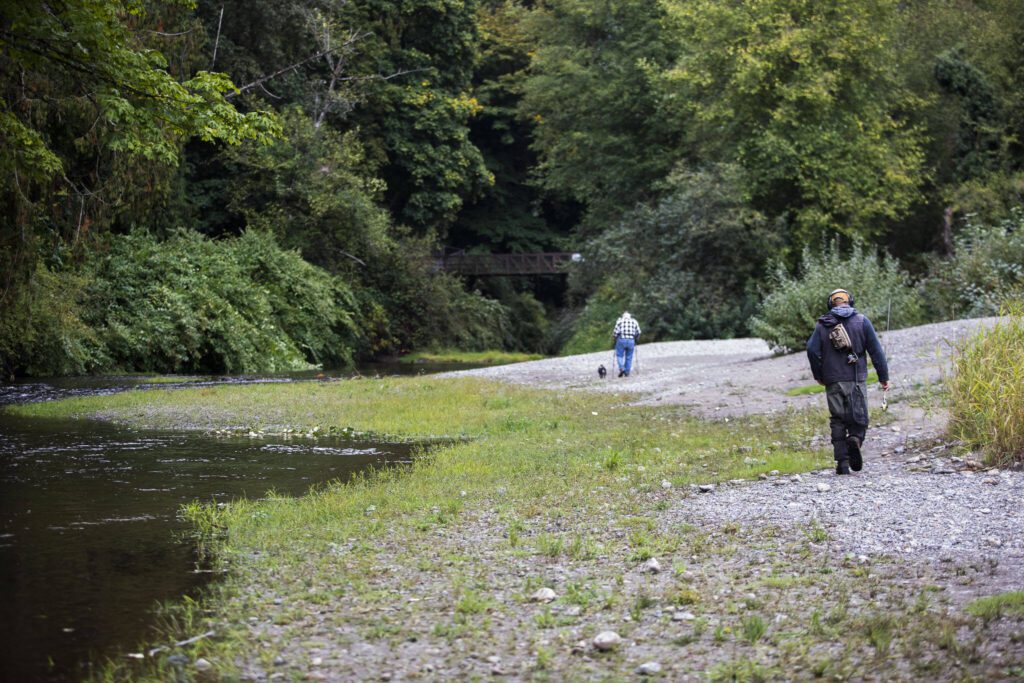MONROE — Over a thousand salmon waited in the shadow of a beaver dam over Woods Creek on Monday morning. Many had been stationed there for several days.
The salmon — a mix of pink, coho and endangered Chinook — swam against the current. Some found spots to breach the dam, flopping across debris to get to the other side.
Many swam in place in anticipation for something, anything, to happen at the edge of Al Borlin Park in Monroe.
They are the first group of salmon to benefit from a more than $1.4 million restoration project less than a mile away. The Adopt a Stream Foundation, in partnership with several environmental organizations, helped remove a 165-foot creosote railroad trestle that impeded their migration for decades.
Some biologists used to believe beaver dams hindered salmon migration, too. But staff from Adopt a Stream said coho salmon especially benefit from the dams, which create ponds for juveniles to rear in.
Coho in Woods Creek travel all the way into the upper tributaries of the watershed, said Anna Gilmore, an ecologist with Adopt a Stream. Typically, those higher-elevation areas are pretty dry, she said, making it difficult for fish to spawn.
“By forcing the coho to wait, now we’re getting all this rain,” Gilmore said. “That’s putting water up in the watershed, so there’ll be water the whole way.”
The weekend rain helped water levels rise, too. Standing on the side of the creek, the dam — a tangle of branches and knotweed — burst from the rain in a matter of minutes. Dirt flooded the creek as debris flowed downstream. At last, the salmon would be able to continue their journey.
The 84-year-old trestle north of the beaver dam was coated with creosote — a wood preservative toxic to salmonids and other aquatic life. Under the bridge, debris and sediment had collected, too, making it difficult for salmon to move upstream when the creek was low.
Gilmore and Mollie Brown, a stream restoration technician for Adopt a Stream, were stationed downstream for a removal process that lasted about a week. They monitored the turbidity, or cloudiness, of the water to ensure it didn’t get too hazy for fish. If it did, work stopped.
Gilmore and Brown also netted any creosote wood pieces that escaped the containment area and put them on shore. Project workers placed oil booms in the water to prevent contamination as well.
The structure was “impeding upstream migration of adults and, more importantly, downstream migration of smolts too,” said Walter Rung, senior ecologist for Adopt a Stream.
Adopt a Stream began assessing the feasibility of the trestle’s removal in 2016. The owners of the trestle, including the Burlington Northern Santa Fe railway and Snohomish County Parks, were “really supportive,” Rung said.
Securing funding for the project was more complicated. According to Adopt a Stream, $1.2 million in habitat restoration funds trickled down from NOAA, the state Department of Fish and Wildlife, and Snohomish County Surface Water Management.
“All those steps took a lot of time,” Rung said.
Once construction began on Sept. 6, workers had nine days to demolish the trestle.
“As soon as adult salmon come back, you’re not allowed to work in the water because you will interfere with their migration,” Rung said. “Any delays in their upstream migration could result in pre-spawn mortality.”
The Snohomish County Public Utility District funded the construction of logjams near the site of the former trestle, providing erosion control and juvenile salmon habitat.
The project was completed before the work window closed Sept. 15, Gilmore said.
Adopt a Stream staff and volunteers will start planting native vegetation near the site of the previous trestle this fall, in a continuing long-term effort to restore the riparian zone.
The grant from NOAA also requires three years of monitoring, to observe how the site changes, though Rung said it will likely take four to eight years to see the complete results of this project, as salmon mature in the ocean and return to spawn in freshwater.
“It’s definitely a win,” Rung said, “in the ongoing battle for salmon recovery.”
Ta’Leah Van Sistine: 425-339-3460; taleah.vansistine@heraldnet.com; Twitter: @TaLeahRoseV.
Talk to us
> Give us your news tips.
> Send us a letter to the editor.
> More Herald contact information.
































